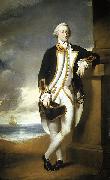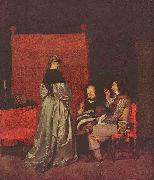George Dance the Younger Huiler la Reproduction de TableauAll George Dance the Younger Oil PaintingsGeorge Dance the Younger (1 April 1741 - 14 January 1825) was an English architect and surveyor. The fifth and youngest son of George Dance the Elder, he came from a distinguished family of architects, artists and dramatists. He was hailed by Sir John Summerson as "among the few really outstanding architects of the century", but few of his buildings remain. He was educated at the St. Paul's School, London. Aged 17, he was sent to Italy to prepare himself for an architectural career and joined his brother Nathaniel, who was studying painting in Rome. George was a member of academies in Italy, showing much promise as a draughtsman, and much of his later work was inspired by Piranesi, with whom he was acquainted. He succeeded his father as City of London surveyor and architect on his father's death in 1768, when he was only 27. He had already distinguished himself by designs for Blackfriars Bridge, sent to the 1761 exhibition of the Incorporated Society of Artists. His earliest London project was the rebuilding of All Hallows-on-the-Wall church in 1767. His first major public works were the rebuilding of Newgate Prison in 1770 and the front of the Guildhall, London. His other London works include the church of St Bartholomew-the-Less (1797). In Bath he largely designed the Theatre Royal, built by John Palmer in 1804-5. Sir John Soane was a pupil. Many of his buildings have been demolished, including the Royal College of Surgeons, Newgate Prison, St Luke's Hospital for Lunatics, the Shakespeare Gallery in Pall Mall, the library at Lansdowne House, the Common Council Chamber and Chamberlain's Court at the Guildhall, Ashburnham Place, and Stratton Park (demolished save for its Tuscan portico) With his brother Nathaniel, he was a founder member of the Royal Academy in 1768, and its second professor of architecture, from 1798 to 1805. For a number of years, he was the last survivor of the 40 original Academicians. |
|||

|
|||
|
|
|||
|
||||||||||||
| George Dance the Younger George Dance the Younger (1 April 1741 - 14 January 1825) was an English architect and surveyor. The fifth and youngest son of George Dance the Elder, he came from a distinguished family of architects, artists and dramatists. He was hailed by Sir John Summerson as "among the few really outstanding architects of the century", but few of his buildings remain. He was educated at the St. Paul's School, London. Aged 17, he was sent to Italy to prepare himself for an architectural career and joined his brother Nathaniel, who was studying painting in Rome. George was a member of academies in Italy, showing much promise as a draughtsman, and much of his later work was inspired by Piranesi, with whom he was acquainted. He succeeded his father as City of London surveyor and architect on his father's death in 1768, when he was only 27. He had already distinguished himself by designs for Blackfriars Bridge, sent to the 1761 exhibition of the Incorporated Society of Artists. His earliest London project was the rebuilding of All Hallows-on-the-Wall church in 1767. His first major public works were the rebuilding of Newgate Prison in 1770 and the front of the Guildhall, London. His other London works include the church of St Bartholomew-the-Less (1797). In Bath he largely designed the Theatre Royal, built by John Palmer in 1804-5. Sir John Soane was a pupil. Many of his buildings have been demolished, including the Royal College of Surgeons, Newgate Prison, St Luke's Hospital for Lunatics, the Shakespeare Gallery in Pall Mall, the library at Lansdowne House, the Common Council Chamber and Chamberlain's Court at the Guildhall, Ashburnham Place, and Stratton Park (demolished save for its Tuscan portico) With his brother Nathaniel, he was a founder member of the Royal Academy in 1768, and its second professor of architecture, from 1798 to 1805. For a number of years, he was the last survivor of the 40 original Academicians. |
||||||||||||
|
|
||||||||||||
| ID de tableau:: 81122 Portrait of Captain Hugh Palliser Portrait of Captain Hugh Palliser before 1775(1775) Medium Oil on canvas Dimensions 243.9 x 152.4 cm cyf before 1775(1775) Medium Oil on canvas Dimensions 243.9 x 152.4 cm cyf |
||||||||||||
|
|
||||||||||||
| ID de tableau:: 81925 Paternal Admonition Paternal Admonition Date ca. 1654-1655 Medium Oil on canvas Dimensions 72 x 60 cm cyf Date ca. 1654-1655 Medium Oil on canvas Dimensions 72 x 60 cm cyf |
||||||||||||
|
|
||||||||||||
|
| Artiste précédent Artiste prochain | |||||||||||
|
|
||||||||||||
|
George Dance the Younger George Dance the Younger (1 April 1741 - 14 January 1825) was an English architect and surveyor. The fifth and youngest son of George Dance the Elder, he came from a distinguished family of architects, artists and dramatists. He was hailed by Sir John Summerson as "among the few really outstanding architects of the century", but few of his buildings remain. He was educated at the St. Paul's School, London. Aged 17, he was sent to Italy to prepare himself for an architectural career and joined his brother Nathaniel, who was studying painting in Rome. George was a member of academies in Italy, showing much promise as a draughtsman, and much of his later work was inspired by Piranesi, with whom he was acquainted. He succeeded his father as City of London surveyor and architect on his father's death in 1768, when he was only 27. He had already distinguished himself by designs for Blackfriars Bridge, sent to the 1761 exhibition of the Incorporated Society of Artists. His earliest London project was the rebuilding of All Hallows-on-the-Wall church in 1767. His first major public works were the rebuilding of Newgate Prison in 1770 and the front of the Guildhall, London. His other London works include the church of St Bartholomew-the-Less (1797). In Bath he largely designed the Theatre Royal, built by John Palmer in 1804-5. Sir John Soane was a pupil. Many of his buildings have been demolished, including the Royal College of Surgeons, Newgate Prison, St Luke's Hospital for Lunatics, the Shakespeare Gallery in Pall Mall, the library at Lansdowne House, the Common Council Chamber and Chamberlain's Court at the Guildhall, Ashburnham Place, and Stratton Park (demolished save for its Tuscan portico) With his brother Nathaniel, he was a founder member of the Royal Academy in 1768, and its second professor of architecture, from 1798 to 1805. For a number of years, he was the last survivor of the 40 original Academicians. |
||||||||||||
|
|
||||||||||||
|
CONTACTER DES Etats-Unis |







